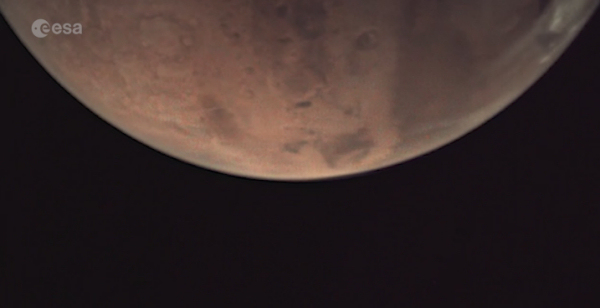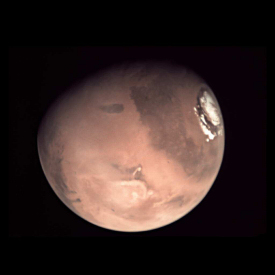Mars Webcam goes pro
25 May 2016
A modest 'webcam' on Mars Express has proven useful for outreach, education and citizen-science. Now ESA have decided to adopt it as a professional science instrument.
 |
| Looking at the limb of Mars with VMC [Click to access the video]. Credit: ESA/Mars Express/VMC, CC BY-SA 3.0 IGO |
Mars Express was launched in 2003 with a simple, low-resolution camera to provide visual confirmation that its Beagle 2 lander had separated. Once that was done, the camera was switched off, and the craft got on with its main mission using its 'real' scientific instruments.
In 2007, ESA's flight controllers switched it back on to see if it could still be used, possibly for education or science outreach, without interfering with routine operations or the mission's prime science investigations.
It still worked well, and the camera's unique vantage point meant it could, for example, capture crescent images of Mars impossible from Earth. Its wide field of view provides global images of the Red Planet, a capability available on only one other Mars craft, India's orbiter.
Global community
 |
| Mars stack. Credit: ESA/D. O'Donnell - CC BY-SA IGO |
"The Mars Webcam has since become hugely popular among a keen and growing community of students, educators, artists and citizen-scientists in dozens of countries in Europe, the Americas, Australia, Africa and Asia," notes Spacecraft Operations Manager Michel Denis.
Enthusiasts have downloaded, shared and processed images to enhance certain features or boost clarity. Many of these have in turn been reshared via social media. Others have developed software for colour processing or other improvements. Some have even used the images to analyse cloud and aerosol behaviour in the atmosphere, or to determine cloud altitudes.
Today, images are automatically posted to a dedicated Flickr page, on several occasions within 75 minutes of being acquired at Mars, and these are freely shared under a Creative Commons licence.
Millions of views
The page now features over 19 000 images that have been viewed over two million times. The Twitter account has been viewed millions of times.
Most recently, 25 schools and youth clubs in Europe and the US were invited last year to submit imaging requests, and subsequently used their images in a wide variety of scientific, educational and artistic projects.
ESA has long fostered similar outreach efforts, including, for example, the Cooperation through Education in Science and Astronomy Research, or CESAR, project in Spain.
Now, after almost a decade's service in outreach, the camera is getting a boost.
Professional promotion
This spring, ESA began working with the Planetary Sciences Group of the University of the Basque Country, Spain, for an initial two years to develop software and conduct studies of images, effectively promoting the humble camera to the level of professional science instrument.
"The analysis will help us understand the global martian context of data acquired from other instruments, provide data on clouds, dust and atmospheric structures and enable surface features to be accurately characterised, for example, by tracking variations in the Mars polar ice cap," says Agustín Sánchez-Lavega, heading the group.
Mars Express Project Scientist Dmitri Titov is delighted that the camera is opening up a new range of investigations at Mars: "Cloud tracking and dust storm monitoring, for example, are significant topics in the planetary community, and it will allow us to extend Mars Express science 'into the atmosphere', filling a gap in the spacecraft's science portfolio."
"Thanks to the outreach, education and social media experience, we've long suspected that it has intrinsic science value, and now this research group in Spain is keen on joining us in exploiting these images on a professional level."
"This new research will support the main Mars Express investigations and significantly increase the value of our 13 year-old mission."
The camera's images will continue to be made available to the public as they have been.
This article was originally published on ESA's Space Operations Portal


